Hypselodoris bullocki - Page 3
See Page 1, Page 2.
See Hypselodoris apolegma, which may be a colour form.
Rudman, W.B., 2001 (April 3) Hypselodoris bullocki - Page 3 [In] Sea Slug Forum. Australian Museum, Sydney. Available from http://www.seaslugforum.net/find/hypsbull3
Related messages
Re: Blue Hypselodoris bullocki egg-laying
March 3, 2009
From: Barbara Hanchard


Concerning message #12058:
Bill,
Unable to get a picture of the eggs actually coming out of the genital opening which would confirm that this animal was actually laying the egg ribbon and not transiting over it. Numerous others close by on the move and feeding but I didn't think to take photos of the ones feeding. While I find these slugs right across this dive site (Leilei, Honiara) they seem to congregate in larger numbers in one particular spot. Hope the photos are of some use.
Locality: Leilei, Honiara, 12 meters, Solomon Islands, Pacific, 21 February 2009, Sandy slope. Length: 30 mm. Photographer: N.Barbara Hanchard.
Barbara
nbhanchard@gmail.com
Hanchard, N.B., 2009 (Mar 3) Re: Blue Hypselodoris bullocki egg-laying. [Message in] Sea Slug Forum. Australian Museum, Sydney. Available from http://www.seaslugforum.net/find/22275
Thanks Barbara,
I wouldn't be surprised if this is the egg mass of this animal, as most of the 'colour forms' or species I am lumping in Hypselodoris bullocki [and H. apolegma] have this shaped and coloured egg ribbon [see message #7110] . Interestingly, the photo your refer to [#12058] has a rather sinuous ribbon with multiple coils rather than the stiff ribbon of about one and a half coils which yours has. The ribbons I have seen are usually as in your animal, but as you will see on the Forum, sometimes there are multi-coiled ribbons and they are not confined to a specific colour form.
I was interested in your suggestion that this species tends to congregate in one spot. While this may be the result of some peculiar physical conditions -such as light or water currents - I wouldn't be surprised if it coincided with the presence of its food sponge or perhaps a large concentration of the food sponge at that site. Perhaps there are good growing conditions for the sponge at that spot. Have a look at photos in messages #19355; #16260 for good photos of its favourite food Euryspongia.
Best wishes,
Bill Rudman
Re: Hypselodoris bullocki? again
November 27, 2008
From: Marcel Tanke

Concerning message #1747:
Dear Bill,
In the above message, you doubt whether the very blue colour is real. Or caused by the photograpy. The picture attached of a similar specimen we found in Puerto Galera, indeed shows a more pinkish and lighter blue color; thus supporting your point of view.
Locality: Puerto Galera, 15 m, Philippines, 11 February 2008, Sandy bottom. Length: 5 cm. Photographer: Marcel Tanke.
Best regards,
Marcel
marceltanke@cs.com
Tanke, M.A., 2008 (Nov 27) Re: Hypselodoris bullocki? again. [Message in] Sea Slug Forum. Australian Museum, Sydney. Available from http://www.seaslugforum.net/find/21737
Thanks Marcel,
It looks like the colour in this colour form or species varies from a very dark blue to the lighter colour in your photos. The broad white band around the mantle edge is reminiscent of Hypselodoris apolegma [see #19710] but in H. apolegma the white border does not have the distinct inner edge that your animals have. But as I have discussed before, is H. apolegma really a distinct species?
Because of this difference to the mantle border, I have kept specimens such as yours [see #2073, #1747, #2274, #18974, #16653] as part of the H. bullocki group. One other point is that the gill colour of these blue ones differs from orange, as in your animals, to deep blue [#20665]. What it all means, I have no idea. Some years ago I tried without success to find anatomical differences between different colour forms, and as you will see on the Forum ,we have at least two examples of different colour forms, or species, mating [see #6816, #20968]. Mating only with ones own kind is a basic tenet of the species concept. If the different colour 'forms' are different species, then H. apolegma is surely a particularly incompetent species.
Best wishes,
Bill Rudman
Hypselodoris bullocki? feeding
April 29, 2008
From: Kenneth Yong

Dear Bill,
Here's a very blue Hypselodoris bullocki which looks like it's feeding on a reddish sponge. You probably know that this particular color form is very common from the Sipadan-Mabul-Kapalai islands -- you do have quite a few contributions of this color form from Mabul and Kapalai.
I have yet to see a "typical" pinkish H. bullocki from here, and I've done hundreds of dive in the area!
Locality: Mabul Island, Eeel Garden divesite, 10 m, Sabah, Malaysia, Celebes Sea, 16 July 2007, Fringing coral reef. Length: 5-7 cm. Photographer: Kenneth Yong.
BTW, Asther Lau, who has contributed quite a few photos, and 2 of this color form, was my wife Letizia's dive instructor, and I recently met, and dived with, Mike Krampf, another of your regular contributors, in Bali. Talk about a forum uniting a very small world!
Another reason why I sent this photo is because I can't see its yellow rhinophores although the head looks like it's turned this way. What do you think happened?
Thanks a million,
Kenneth
kyong67@tiscali.it
Yong, K., 2008 (Apr 29) Hypselodoris bullocki? feeding. [Message in] Sea Slug Forum. Australian Museum, Sydney. Available from http://www.seaslugforum.net/find/20665Dear Kenneth,
Concerning the rhinophores, I am not sure if your is one with blue rhinophores rather than yellow - if so, they could just be retracted. Another possibility is that some fish as bitten them off - if so it should be able to regrow them. I am not sure just what the limits of Hypselodoris bullocki are. I have continued to include this blue form with a broad white border as a colour form of H. bullocki, but I am sure someone is itching to name it as a new species. It has at least 3 colour forms, one in which the rhinophores and the gills are the same colour as the body [see message #2073, #15410], another which has yellow (or orange) gills and rhinophores [message #1747]; and a third which has yellow (or orange) rhinophores and blue gills [message #18974]. Similar variability can also be seen in the pinkish animals with a narrow white border.
Concerning possible feeding. The pink lump the animal is on is in fact a plant. It is what we call a coralline algae. Thewse algae are a group of red algae which accumulate calcium carbonate in their tissues. Some grow jointed 'fronds' a bit like the green alga Halimeda, while others - like in your photo - slowly deposit layers to form lumpy 'rocks'.
I'm glad to see the Forum is a force in uniting slug fanatics worldwide.
Best wishes,
Bill Rudman
Re: Purple sea slug
April 23, 2008
From: Ben Newsome
Concerning message #4316:
How would you know what they eat if you can't tell us what they eat?
Ben Newsome
ob1bog@aol.com
Newsome, B., 2008 (Apr 23) Re: Purple sea slug. [Message in] Sea Slug Forum. Australian Museum, Sydney. Available from http://www.seaslugforum.net/find/21544Dear Ben,
Good question - but you are confusing various levels of information. Although I didn't know exactly what they ate I certainly knew that they didn't eat plant material. From my knowledge of the anatomy of this family of nudibranchs it is quite clear that they are carnivores not herbivores. Just like a mammal expert can distinguish carnivores from herbivores from aspects of their anatomy, an expert on molluscs can do the same with sea slugs. In fact all nudibranchs are carnivores, which makes the advertisement from Aquacon that they have 'nudibranchs' which 'will take care of your algae' quite irresponsible and quite incorrect.
Since that message was posted in 2001 I have published a research paper which brings together all the information we have on precise food choice in this family (Rudman & Bergquist, 2007) which shows that Hypselodoris bullocki and closely related species feed exclusively on sponges of the genus Euryspongia (Fam: Dysideidae). However knowing this name or even the precise species of sponge they eat is of little value to aquarium enthusiasts because sponges are extremely difficult to collect and keep alive in aquaria, even if the collectors could correctly identify the species. Also, if you had the right sponge, and found just the right conditions to keep a colony alive in a tank, your aim is basically to sabotage your sponge husbandry by letting a nudibranch loose on this fragile sponge colony to eat it alive! Damaged sponges quickly rot and die and produce or release toxic chemicals into the water which will soon foul your aquarium. I have said this many times before so have a look at the messages listed under Keeping Sea Slugs in captivity for more comments on the topic.
- Rudman, W. B. & Bergquist, P. R. (2007) A review of feeding specificity in the sponge-feeding Chromodorididae (Nudibranchia: Mollusca). Molluscan Research, 27(2): 60-88
Best wishes,
Bill Rudman
Hypselodoris bullocki ? from Papua New Guinea
August 18, 2007
From: Bob Gaensslen

Does anyone recognize this animal?
Locality: Around New Britain, 40 fsw, Papua New Guinea, Bismark Sea, 7-28-07, Coral reef. Length: 1.5-2.0 inches. Photographer: Bob Gaensslen.
Bob Gaensslen
reg@uic.edu
Gaensslen,R.E., 2007 (Aug 18) Hypselodoris bullocki ? from Papua New Guinea. [Message in] Sea Slug Forum. Australian Museum, Sydney. Available from http://www.seaslugforum.net/find/20471Dear Bob,
This is either an example of one species with a very variable colour pattern, or a group of similar species. I am at present lumping most of them together as Hypselodoris bullocki until a more convincing solution is proposed.
Best wishes,
Bill Rudman
Hypselodoris bullocki feeding
May 14, 2007
From: Richard Swann


Hi Bill
I have attached a few pictures of Hypselodoris bullocki feeding.
Locality: Clement reef Gaya island, Kota Kinabalu, 19 meters, Sabah, Borneo, South China Sea, 11 May 2007, Out Reef slope. Length: 30mm. Photographer: Richard Swann.
In the first two images I wasn't 100% sure as I could not see any obvious evidence of eaten sponge but I then noticed along the dorsum a red substance moving from front to back. In the lower photo you can see the red of the sponge being digested.
I know you have lots of feeding records for this species but I felt that the sponge had more red colouration than others that I had seen and as a result was worth a post.
Best regards
Richard
www.downbelow.co.uk
richard@downbelow.co.uk
Swann, R., 2007 (May 14) Hypselodoris bullocki feeding. [Message in] Sea Slug Forum. Australian Museum, Sydney. Available from http://www.seaslugforum.net/find/19903
Dear Richard,
Thanks again. Although we do have a number of records of this species feeding, it is not many in comparison with our knowledge of feeding in other animal groups. It looks like this species specialises on the dysideid sponge genus Euryspongia but I am reluctant to say we have enough evidence just yet. The little clump of sponge in your photo well illustrates the problem of building up feeding information, because often the sponge colonies are not obvious like in Poppe's message [#16260] but very small, or partly covered in temporary mud or debris and so difficult for us to see.
Your photo of sponge fragments travelling down the oesophagus to the stomach is pretty indisputable evidence.
Best wishes,
Bill Rudman
Hypselodoris bullocki from the Great Barrier Reef
March 15, 2007
From: Richard Ling

Dear Bill,
Attached is a photo of two nudibranchs taken during an exploratory dive on an unnamed bommie a short way north of Port Douglas. I've compared it with photos of Hypselodoris bullocki here and elsewhere and it looks like a match. Do you agree?
Locality: Port Douglas, about 15 metres, Queensland Australia, Great Barrier Reef, 12 August 2005, Inshore bommie. Photographer: Richard Ling.
Best regards
Richard Ling
richard@research.canon.com.au
Ling R B, 2007 (Mar 15) Hypselodoris bullocki from the Great Barrier Reef. [Message in] Sea Slug Forum. Australian Museum, Sydney. Available from http://www.seaslugforum.net/find/19608Dear Richard,
Yes this is the 'typical' colour form of Hypselodoris bullocki. You will see there are a number of colour forms with this rather high, narrow, body. There is some debate over whether they are a group of related species or one species with a number of colour forms. I am always interested in photos of these animals feeding,as they are helping us to build up information on their natural history and to find out just how specific each species is when it comes to diet. Your photo clearly suggests that these two are busy feeding on a sponge, but as often happens, the sponges in your photo are obscured by both the slugs and overgrowths on the sponges.
Best wishes,
Bill Rudman
Hypselodoris bullocki - feeding record
February 13, 2007
From: Bill Rudman

I have been searching through old correspondence and notes for further records of feeding in chromodorids or close associations with sponges, and found this photo from Ian Knight, who provided many valuable specimens from the Solomon Islands. It shows an animal on Euryspongia.
Locality: Bonege Island, Guadacanal, Solomon Islands. 26 November 1983. Photo: Ian Knight.
We now have many records of Hypselodoris bullocki feeding or closely associated with this species of the dysideid sponge genus Euryspongia.
Bill Rudman
Rudman, W.B., 2007 (Feb 13) Hypselodoris bullocki - feeding record. [Message in] Sea Slug Forum. Australian Museum, Sydney. Available from http://www.seaslugforum.net/find/19355Re: Hypselodoris bullocki? from Malaysia
December 11, 2006
From: Asther Lau

Concerning message #15410:
Hello Bill,
Upon my return to Mabul Island, Sabah, I came across another of the very blue Hypselodoris bullocki. The color of its rhinophore is more distinct here. Hope it'll be useful for the forum.
Locality: Mabul Island, Tawau, Approx. 12 metres, Sabah, Malaysia, Celebes Sea, 25 September 2006, Muck diving. Length: About 4 1/2 cm. Photographer: Asther M. Lau.
Regards,
Asther
asther@astherlau.com
Lau. A, 2006 (Dec 11) Re: Hypselodoris bullocki? from Malaysia. [Message in] Sea Slug Forum. Australian Museum, Sydney. Available from http://www.seaslugforum.net/find/18974Dear Asther,
Thanks for this record. This 'species' or 'colour form' is certainly very distinctive.
Best wishes,
Bill Rudman
Hypselodoris bullocki from Indonesia
November 22, 2006
From: Charles Rowe

Hi Bill,
I am not sure but I believe this is Hypselodoris bullocki. Can you please confirm this. It was taken on a trip to Sepa Island near Jakarta in Indonesia on a trip we took to visit a friend who lives there.
Locality: Sepa Island, One Thousand Islands, 10 metres, Indonesia, Ocean, 19 September 2006, Reef slope in debris. Photographer: Charles Rowe.
Charles Rowe
bumff@mweb.co.za
Rowe, C., 2006 (Nov 22) Hypselodoris bullocki from Indonesia. [Message in] Sea Slug Forum. Australian Museum, Sydney. Available from http://www.seaslugforum.net/find/18477Dear Charles,
Yes I would call this a colour form of H. bullocki.
Best wishes,
Bill Rudman
Re: H. bullocki feeding - or at least tasting
August 3, 2006
From: Leslie Harris


Concerning message #17285:
Hi Bill, Brian --
The worm is a syllid, most likely a Haplosyllis. There are a number of species currently reported as Haplosyllis spongicola (but mostly undescribed) which live on sponges & other sessile animals. They can occur by the thousands on sponges. I've never seen them defend a sponge but I've certainly seen them bite & attach themselves to other animals in the lab. It wouldn't surprise me to learn these defend their hosts just like other sponge associates such as the eusocial alpheids.
Haplosyllis feeds on cell contents or body fluids. It everts its proboscis (green arrows) which is armed with one or more teeth, punctures the body/cell wall of its prey & then sucks out the contents. The proventricle (blue arrows) is a barrel-shaped structure made of rings of muscle cells. It functions as a pump to create the suction.
Thanks for posting this series of pictures. It's great to learn more about interactions between two of my favorite groups of animals.
Leslie Harris
lharris@nhm.org
Harris, L.H., 2006 (Aug 3) Re: H. bullocki feeding - or at least tasting. [Message in] Sea Slug Forum. Australian Museum, Sydney. Available from http://www.seaslugforum.net/find/17308Dear Leslie,
Thanks very much for the background information. As you may have noticed, I am very weak when it comes to following my own rules on only answering questions on sea slugs. Any slight connection usually leads me astray. Unfortunately we usually only get to study our particular animal group after they are dead and preserved, so I take any opportunity to build up information on them as living things.
Best wishes,
Bill Rudman
Re: Hypselodoris bullocki feeding - or at least tasting
August 1, 2006
From: Brian Francisco

Concerning message #17283:
Bill
I can't believe your explanation didn't occur to me before. Upon review of a few other photos (attached), it's clear that the sponge was indeed occupied.
You're right; nothing is easy. It's astonishing that sea slugs like this Hypselodoris bullocki ever find food, let alone one another, amidst the gauntlet of stinging, biting, and otherwise annoying microscopic 'wildlife' they must encounter along the way.
Locality: Tasi Tolu, 13 meters, East Timor, Banda Sea, 30 July 2006, coral rubble. Length: 3 cm. Photographer: Brian Francisco.
Thanks very much for the enlightening explanation.
Brian
www.uwet.net
uwet.blogspot@gmail.com
Francisco, B., 2006 (Aug 1) Re: Hypselodoris bullocki feeding - or at least tasting. [Message in] Sea Slug Forum. Australian Museum, Sydney. Available from http://www.seaslugforum.net/find/17285
Dear Brian,
It's nice to know at least one of my explanations is credible! I've seen these little worms in action before. I am not sure if they are just fierce protectors of their 'home' or whether their survival strategy is to have a quick bite at anything that passes by. Whatever it is, it certainly deters Hypselodoris.
Best wishes,
Bill Rudman
Hypselodoris bullocki feeding - or at least tasting
July 31, 2006
From: Brian Francisco

Hi Bill
I seem to remember a comment you made recently about the difficulty in discerning feeding behaviours unless the animal is actually seen biting into something. We saw this H. bullocki feeding today and thought I'd snap a few photos to send to you. Now my problem is that I'm not exactly sure what the animal bit into. And it was more like a taste...two bites and off again to find something more appetizing.
Locality: Tasi Tolu, 13 meters, East Timor, Banda Sea, 30 July 2006, coral rubble. Length: 3 cm. Photographer: Brian Francisco.
The following photos are in sequence of a few seconds.
Brian
www.uwet.com
uwet.blogspot@gmail.com



Dear Brian,
Nothing's ever simple! I am pretty sure that Hypselodoris bullocki feeds only on the dysideid sponges of the genus Euryspongia. The purplish object is a small sponge colony and from its general shape I would say it could well be a dysideid. However I can't see enough detail to be sure. If you look on the Fact Sheet, and the recent message [#16260] from the Poppes, you'll see that Euryspongia has a very characteristic arrangement of fibres.
As to the animal not staying to finish the meal. I suspect it was not so much the sponge that was not to its taste but the 'wildlife' on the sponge. In the close-up alongside you can see at least one polychaete worm apparently disturbed by the nudibranch's presence. When sponge colonies are large they are often quite clean of other animals, but when they are small they are often home and or substrate to worms, crustacea and other invertebrates. Nudibranchs are often quite sensitive to pokes, prods, bites and even stings from other animals, and I suspect this may be the case here.
Best wishes,
Bill Rudman
Hypselodoris bullocki? - Feeding ?
May 27, 2006
From: Kerem Turker

Dear Bill,
Here are two Hypselodoris [H. bullocki? H. apolegma?] on the same diving location 20 meters from each other, which I think are feeding (I could not get a clear picture, whether this is actually a feeding action) on the same kind of sponge.
Locality: Island, 16 m, Kapalai - Malaysia, Celebes Sea, 09 November 2005, Sandy bottom with partly reef structure. Length: ~60 - 80 mm . Photographer: Kerem Turker.
Best Regards,
Kerem
kerem.turker@pmintl.com



Dear Kerem,
Firstly this species is part of what I have been calling the Hypselodoris bullocki group, for want of a better name, but I don't think it is actually Hypseldoris bullocki or H. apolegma. It will probably need a new name. For convenience I am leaving these unnamed species which look quite like H. bullocki with that species until they are sorted out.
As to its feeding. Although it looks like it couold be feeding, in both cases I am pretty sure the pinkish thing it is on is a large sea squirt or ascidian. certainly in the middle left photo there are small ascidians in the background and it is crawling over some middle-sized ascidians, so I am pretty sure that the bit in the foreground of that photo is also an ascidian. I have had a careful look at your hi resolution photos and there is no sign of the texture and pores that you would expect to see in a sponge.
Best wishes,
Bill Rudman
Hypselodoris bullocki - feeding
April 10, 2006
From: Guido & Philippe Poppe

Dear Bill
Here are some photos of Hypselodoris bullocki you may find interesting from our website on Philippines marine life at
http://www.poppe-images.com/.
Upper & middle left photo: Ziczac Point, Olango Island, Cebu, Philippines.16 m. 2005. Middle right & Lower photo: Hadsan, Mactan Island, Cebu, Philippines. 25 m. 2005. Photos: Copyright Guido & Philippe Poppe.
Best wishes,
Guido & Philippe Poppe
philippe@conchology.be

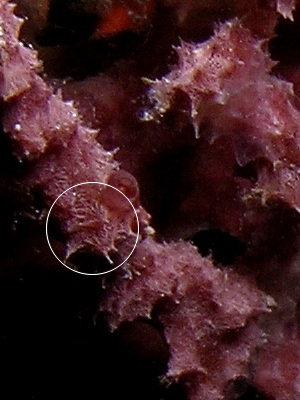
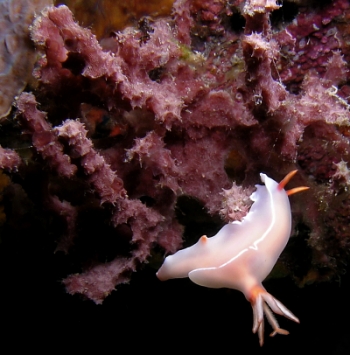
Dear Guido & Philippe,
Thanks for these photos of H. bullocki on the same sponge as I photographed it on in New Caledonia [see Fact Sheet], which has been identified by Pat Bergquist as a species of Euryspongia. The two records again show how variable growth form can be in sponges. the upper photo showing a sponge with quite delicate radiating ridges which are invisible in most of the other sponge except for a small place on the close-up [middle right photo].
Best wishes,
Bill Rudman
Hypselodoris bullocki in aquarium
March 7, 2006
From: Jim Steil
All i have read about this slug is true, it is very very hard to find food for them. I have had a small amount of luck with the dark red algae and sponge food. I have 2, both being different in color of horns and back flower. Still i love the look and will keep trying to serve them as best i can. You have a great forum and i look forward to all the new postings.
Thanks so much
Jim Steil.
jsteil1098@wi.rr.com
Steil, J.R., 2006 (Mar 7) Hypselodoris bullocki in aquarium. [Message in] Sea Slug Forum. Australian Museum, Sydney. Available from http://www.seaslugforum.net/find/16027Dear Jim,
I'm afraid the only food that will keep them alive is the right sponge. Glad you like the Forum
Best wishes,
Bill Rudman
Hypselodoris bullockii? from Malaysia
December 14, 2005
From: Asther Lau

Dear Bill,
I'm a bit confused with this nudi (image attached). Is this a Hypselodoris bullockii? Some books ID this as Hypselodoris sp., common name as Purple-Gilled Hypselodoris.
Locality: Mabul Is., Sabah, Malaysia. Celebes Sea. Depth: 16 metres. Length: 2 cm. Mar 13th, 2004. Muck divesite. Photographer: Asther M. Lau
Hope you can help.
Thank you!
Asther M. Lau
asther@astherlau.com
Lau, A, 2005 (Dec 14) Hypselodoris bullockii? from Malaysia. [Message in] Sea Slug Forum. Australian Museum, Sydney. Available from http://www.seaslugforum.net/find/15410Dear Asther,
As you'll see from other messages on the Forum [see #12058], I have kept this colour form with the more typically coloured animals we identify as H. bullocki, mainly because I am not sure how many species are involved. I looked at the anatomy of mnay of them some time ago but couldn't find any good differences. One colour form has been considered a distinct species [Hypselodoris apolegma] but I can't say I am 100% convinced, especially when we have Phil Slosberg's photo [#6816 ] of two colour 'forms' or 'species' mating. I think we need some more anatomical data before we can be sure. This is a good example of how much we still have to learn about many of these animals. As I often say, photos showing egg-laying, mating, and feeding are very valuable because they can sometimes give us clues to differences between similarly coloured animals, and so suggest where we should be looking for possible species' differences
Best wishes,
Bill Rudman
Re: Hypselodoris bullocki - different colours mating
October 25, 2005
From: Paul Whitehead

Dear Bill,
Concerning your comments about Hypselodoris bullocki - H. apolegma mating or mating of distinct colour variations within a species.[see message #15038], you may find the attached photographs of interest. They are from a trip to Lembeh last October.
Locality: Nudi Falls, Lembeh Straits, Indonesia, Sulawesi. Lembeh Straits.
Depth: 5 meters. Length: 7 cm (larger of specimens). October 2004. Sand and rock strewn area next to wall. Photographer: Paul Whitehead
Paul
pw@whiteheadimages.com
Whitehead, Paul, 2005 (Oct 25) Re: Hypselodoris bullocki - different colours mating. [Message in] Sea Slug Forum. Australian Museum, Sydney. Available from http://www.seaslugforum.net/find/15104
Dear Paul,
A very interesting find. I have in the past considered these to be colour forms of one species, but I know some people would like to make them distinct species. What is particularly interesting is how the smaller one is developing a purple band at the front of the mantle and also on the posterior tip of the foot. I assume this means it is gradually chnaging colour to purple. I had previously discounted a colour change like this as I had found small purple animals and large whitish ones, but I guess this suggests animals can change colour, or at least gain colour, at different sizes.
Best wishes,
Bill Rudman
Blue Hypselodoris bullocki egg-laying
February 1, 2004
From: Matthew


I recently purchased a Hypselodoris bullocki from a local fish store and when I came back from work it appears to have left a yellow sponge-like formation on my live rock. I assume that the nudibranch left it because I've never seen anything like it since I've had the tank. Any idea what it is?
Matthew
matromo@msn.com
Matthew, 2004 (Feb 1) Blue Hypselodoris bullocki egg-laying. [Message in] Sea Slug Forum. Australian Museum, Sydney. Available from http://www.seaslugforum.net/find/12058Dear Matthew,
By coincidence we have had a few messages about this dark blue 'form' of H. bullocki recently. The yellow object is this animal's egg ribbon. It's most probable that the eggs, if there are eggs in the ribbon, are infertile. Unhealthy animals often lay eggs like this before they die, almost as though they are trying to leave some descendants. I don't know if your local fish store told you that these animals are specialised sponge feeders, and it is most unlikely that the store can provide you with the right food. One good thing is that the egg ribbon is a useful piece of information and looks very like a photo in an earlier message. If you look at some of the earlier messages about H. bullocki you will see we still are not sure just which colour 'forms' are different species and which are just variations. It may be that some of the diffferent colour forms can be distinguished by the shape and colour of their egg ribbons, even if we can't find good anatomical differences.
Best wishes
Bill Rudman
Hypselodoris bullocki mating
January 22, 2004
From: Fredy Brauchli

Dear Bill,
Mary Jane Adams' posting of January 19, 2004, [message 11904] shows the blue-purple coloured Hypselodoris bullocki mating.
During my first stay at Sipadan, Malaysian Borneo, I found two different colour forms of Hypselodoris bullocki mating, one with orange and one with purple coloured gills. This picture was taken at the housereef of Mabul Sipadan, in November 1996.
Kind regards,
Fredy
brauchli@subaqua.ch
Brauchli, F., 2004 (Jan 22) Hypselodoris bullocki mating. [Message in] Sea Slug Forum. Australian Museum, Sydney. Available from http://www.seaslugforum.net/find/11986Thanks Fredy,
I have not seen many examples of this deep blue coloured 'form' so any photos showing variability are welcome.
Best wishes
Bill Rudman
Blue Hypselodoris bullocki mating
January 19, 2004
From: Mary Jane Adams

Dear Bill,
I photographed this pair of Hypselodoris bullocki mating on Mabul Island, east of Sabah, Malaysian Borneo on Nov. 27, 2003. This was the first time I had seen this blue-purple color form and I was hopeful that I would find it mating with another color form. However, after 42 dives in the Mabul-Sipadan-Kapalai area this was the only color form of H. bullocki I saw. They were commmon on "Old Lobster Cave" and "Ribbon Valley" divesites on Mabul.
Best regards,
Mary Jane
divepng@yahoo.com
Adams, M.J., 2004 (Jan 19) Blue Hypselodoris bullocki mating. [Message in] Sea Slug Forum. Australian Museum, Sydney. Available from http://www.seaslugforum.net/find/11904Thanks Mary Jane,
Thanks for keeping the H. bullocki puzzle in mind, but as you have discovered they certainly don't want to give away their secrets easily.
Best wishes
Bill Rudman
Hypselodoris bullocki found at Flinders Reef
October 22, 2003
From: Gary Cobb
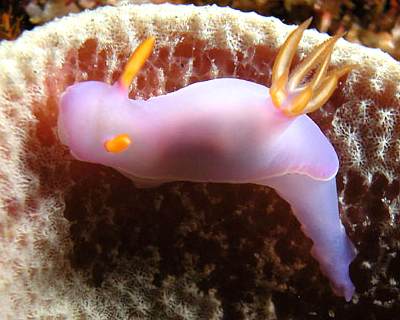
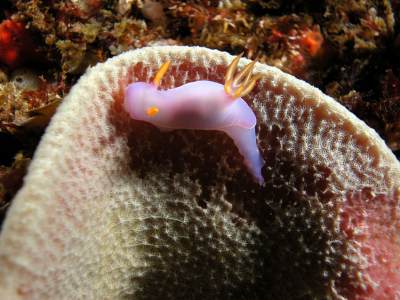
Hi Bill!
I found this animal off Flinders Reef north of Moreton Island, Queensland, Australia. 25m depth, 25mm long. I think she is Hypselodoris bullocki eating her big dinner.
Thanks.
Gary
gary@cobb.com.au
Cobb, G., 2003 (Oct 22) Hypselodoris bullocki found at Flinders Reef. [Message in] Sea Slug Forum. Australian Museum, Sydney. Available from http://www.seaslugforum.net/find/11160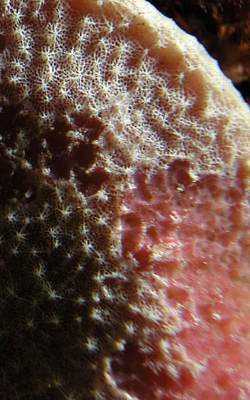
Thanks Gary,
This is excellent evidence of it feeding. In the upper photo we can clearly see a feeding scare around its head, and I have included a close-up alongside to show more clearly the feeding scar in the bottom right of your whole photo. I am already trying to get a positive identification on the sponge
Best wishes
Bill Rudman
Hypselodoris from Anilao
July 21, 2003
From: Ray Izumi

One more photo from Anilao, Batangas, Philippine Islands. This one being what Neville Coleman refers to as the Purple-gilled Hypselodoris, about 5cm in length. You can see its environment from the picture.
I have also seen this same seaslug in Borneo on a reef halfway between Kapalai and Mabul, in 60 feet of water.
Is this in fact a Hypselodoris bullockii or is it still undescribed?
Ray Izumi
izumirm@sprynet.com
Izumi, R., 2003 (Jul 21) Hypselodoris from Anilao. [Message in] Sea Slug Forum. Australian Museum, Sydney. Available from http://www.seaslugforum.net/find/10353Dear Ray,
This is one of a group of 'species' which I still have on the H. bullocki pages. It is quite similar to the one which has been described as H. apolegma, but in that species there is a white network between the white border and the purple colour of the rest of the mantle
Best wishes,
Bill Rudman
H. bullocki + H. apolegma?
May 2, 2003
From: Erwin Köhler

Dear Bill,
Here are 2 more from the Philippines, Malapascua Is., divesite "Nudibranch City" (sic!). I found Hypselodoris bullocki (normal variant) and Hypselodoris apolegma feeding together on the same sponge (Upper Right Image). I did the recommended test and placed them together (of course also to get better shots) watching if there is any reaction like mating. They touched each other (and I swear, I could see how they shook their heads saying "not this one") then turned away (Lower Left)
Data:
Size: H. bullocki 32mm, H. apolegma 26mm
Depth: 16m
Date: 22 February 2003
Erwin
Erwin@medslugs.de


Thanks Erwin,
I think you may have interrupted a happy meal for nothing. I am pretty sure the 'apolegma-like' animal is not what Yonow has described as H. apolegma. In her animal there is a distinct white reticulate pattern between the white border and the purplish mantle. In this animal the junction is abrupt. It has similarities to H. flavomarginata but in that species the margin is yellow and there is a thin opaque white line between that and the pink/purple of the rest of the mantle. At the moment you'll find other photos of this 'colour form' scattered through the H. bullocki pages, although I suspect it's another species.
Best wishes,
Bill Rudman
Re: aquarium slugs
March 10, 2003
From: J.B. McClung

Bill
thanks for your response. sorry about the poor quality of this pic. this is a sea slug that is at a lfs. i have been reading in your forum and am afraid it is destined to a slow death. i am afraid there are not the proper food stuffs in this aquar.hopefully you can id from this pic.
j.b.mcclung
jbmc@bright.net
McClung, J.B., 2003 (Mar 10) Re: aquarium slugs. [Message in] Sea Slug Forum. Australian Museum, Sydney. Available from http://www.seaslugforum.net/find/9367Dear J.B.,
This is one of the 'colour forms' of Hypselodoris bullocki. If you look through the earlier messages on this species you will find other photos with this colour pattern. At present we don't know whether there is one variable species or a number of similarly coloured species. What we are confident about is that they are all sponge feeders NOT algal feeders.
Best wishes,
Bill Rudman
Sea slug for aquarium
March 5, 2003
From: j.b.mcclung
hello.
i hope you have a moment to steer me in a direction about a sea slug i would like to purchase.it is at my lfs a bright purple with tentacles on either end it is grazing algae and has grown .from this description can you id and i will do a search for more info.is it reef safe .if it is will it get along in an established reef with an established fish population along with a mixed popul.of invert.
thanks
j.b.mcclung
jbmc@bright.net
Dear j.b.mcclung
It is impossible to identify things seriously without a fuller description and preferably a photo. It could come from any ocean in the world. If its bright purple it is almost certainly a nudibranch so in spite of what your 'lfs' has told you it will NOT be an algal feeder, so if you buy it you will be sentencing it to a slow death by starvation. It is possibly Flabellina iodinea which is definitely not a herbivore.
Best wishes,
Bill Rudman
Hypselodoris bullocki egg ribbon
February 24, 2003
From: Chris Wahlers

I just got what I think is a blue dorid nudibranch. Today I noticed a yellow noodle looking thing right next to him. Any ideas of what this could be???
I have attached a photo but I couldn't get a good shot where he is hanging out.
Thanks for your help.
Chris
cwahlers@optonline.net
Dear Chris,
Your slug is a colour form of Hypselodoris bullocki, and the 'noodle-like thing' is its egg ribbon. Often when under stress these slugs will lay an egg ribbon. It may be infertile, and even if the eggs hatch, the larvae are unlikely to survive in aquarium conditions. A number of earlier messages have good photos of the egg ribbon.
Best wishes,
Bill Rudman
Egg masses in my aquarium
January 24, 2003
From: Tana Landau
Hi..
I have two sea slugs in my tank. One is a Hypselodoris bullocki and the other I'm unsure of .. may be a Chromodoris magnifica. I just recently obtained these two slugs. One of them laid an egg mass overnight. However I do not know which one. Can you tell me anything about the species imparticular as far as egg masses and characteristics. I know the general info as far as hermaphroditism and veliger larva etc.... I also know some are direct developers while others are not. What would the larvae feed on also. I have a sponge in my tank for them ...thanks for your help.
Tana
Dear Tana,
Firstly, with a little luck I can identify quite a few things from very little information, but I can't work miracles. I can't even guess at your egg mass without a photo or a drawing, or even a few words of description. Its a bit like saying "I have bought a colourful fish - what shall I feed it?" Basically, if you want any sensible information or advice, you have to give me some real clues.
If you have a look at the messages on the H. bullocki page [and pages 2,3] you will see a number of photos of its egg ribbon. If your second species is C. magnifica, then go to the page which describes the flat egg ribbon found in some chromdorid species, including C. magnifica. If your second animal is that species, then you should be able to identify who producd the egg ribbon, as C. magnifica's ribbon is flat.
Now to your other points. Have a look at the List of General Topics for places where I discuss aspects of larval life, and the chance of them surviving in home aquaria. It is not high. Also there is no guarantee the eggs in this ribbon are fertile. Often sick and stressed animals lay eggs ribbons before they die - perhaps a futile attempt to produce a new generation.
Concerning feeding your nudibranchs. You say you have a 'sponge' to feed them. Its like saying you have a 'leaf' to feed a caterpillar. Nudibranchs, like caterpillars, are incredibly choosy. Each species has a particular sponge on which it feeds. I guess its possible, but most unlikely, that you two nudibranchs will eat the same sponge. I am sorry to sound negative, but as I have said many times before, aquarium shops should not be selling nudibranchs. They are just condemning them to a slow death by starvation.
Best wishes
Bill Rudman
Hypselodoris bullocki mating
December 18, 2002
From: Mary Jane Adams

Hi Bill,
These mating Hypselodoris bullocki are the same color, but vastly different in size. The little one was only about 2cm. long, less than half the size of the larger one. Divesite: Nudi Falls, Lembeh Strait, Sulawesi Island, Indonesia, Nov. 22, 2002.
Best regards,
Mary Jane
divepng@yahoo.com
Adams, MJ., 2002 (Dec 18) Hypselodoris bullocki mating. [Message in] Sea Slug Forum. Australian Museum, Sydney. Available from http://www.seaslugforum.net/find/8663Thanks Mary Jane,
It's not often you see such major size differences in mating pairs of nudibranchs, although pairs of quite small individuals are not uncommon. As I have said before, many opisthobranch exhibit what we call protandry, a developmental process in which the male reproductive system, in these hermaphrodite animals, develops much more quickly than the female system. We assume that in matings such as this, the sperm being passed to the smaller partner will be stored in a sperm sac until the animal's female system matures. This is a useful adaptation for animals which meet only by chance.
Best wishes,
Bill Rudman
Hypselodoris bullocki from Reunion
November 16, 2002
From: Marina Poddubetskaia

Dear Bill,
I know you have a lot of photos of Hypselodoris bullocki on the Forum. Anyhow, here is the colour form from Reunion Island, where this species is quite common. This colour form has nice gills and rhinophores: golden yellow with purple base. All specimens I saw there, was coloured exactly like this.
St-Leu, Reunion Island, Indian Ocean. Site: Eboulis Reef. Depth: 9m. Size: 45-50mm. October 10, 2002. Photos: Marina Poddubetskaia - Nembro website
Best wishes,
Marina.
nembro@nembro.info
Poddubetskaia, M., 2002 (Nov 16) Hypselodoris bullocki from Reunion. [Message in] Sea Slug Forum. Australian Museum, Sydney. Available from http://www.seaslugforum.net/find/8369Thanks Marina,
At the moment there is still plenty of room for colour 'forms' of H. bullocki.
Best wishes,
Bill Rudman
Two color forms of H. bullocki mating
November 2, 2002
From: Michael Miller

Dear Bill,
In following up on Erwin Kohler and Phil Slosberg's posting of May 01, 2002. I too came upon a "smoking gun" pairing of a Hypselodoris bullocki and Risbecia apolegma on a recent trip to Bali.
Location: Tulamben, Bali, Indonesia
Date: Sept. 2002
Photographer: Michael D. Miller
Cheers,
Michael Miller
mdmiller@cts.com
Miller, M., 2002 (Nov 2) Two color forms of H. bullocki mating. [Message in] Sea Slug Forum. Australian Museum, Sydney. Available from http://www.seaslugforum.net/find/8334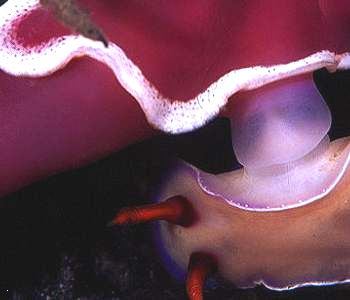
Dear Michael,
The main colour feature distinguishing H. apolegma from typical H. bullocki is the broad opaque white mantle border in H. apolegma, which on the inside edge has a reticulate region of white which can be seen in Phil Slosberg's photo alongside. I would consider your two animals to be dark and pale variations of 'typical' H. bullocki. It would be nice if it was a repeat of Phil's observation but we can't always be lucky.
Thanks again for looking,
Bill Rudman
Hypselodoris bullocki From Riau, Indonesia
June 12, 2002
From: Alice Lee


Hi Bill,
Here are 2 Hypselodoris bullocki photos taken in Riau Archipelago, [Indonesia, just south of Singapore] under very low visibility.
Regards,
Alice
alee@dlink.com.sg
Lee, A., 2002 (Jun 12) Hypselodoris bullocki From Riau, Indonesia. [Message in] Sea Slug Forum. Australian Museum, Sydney. Available from http://www.seaslugforum.net/find/7002Thanks Alice,
Bill Rudman
Re: Hypselodoris bullocki - different colours mating
June 8, 2002
From: Kheong Sann Chan
Hi Bill,
I was just looking at the photo of the 2 shades of H. bullocki mating and I notice that the white one's gills are much smaller than those of the purple one. Do you know of any reason for this? Do you suppose that the size of their gills is related to their age or anything like that?
Kheong.
kschan@mail.dsi.nus.edu.sg
Chan, K.S., 2002 (Jun 8) Re: Hypselodoris bullocki - different colours mating. [Message in] Sea Slug Forum. Australian Museum, Sydney. Available from http://www.seaslugforum.net/find/7178Dear Kheong,
The reason the gills look smaller in the white one is because they are partly withdrawn into a pocket on the back of the animal. The dorid nudibranchs are divided into two 'Superfamilies' - the EUDORIDOIDEA and the ANADORIDOIDEA. One of the main differences between the two is that in the Eudoridoidea the gills can be withdrawn into a pocket for protection. Another name for the superfamily is the 'Cryptobranchia' which basically means 'hidden gills'. In the Anadoridoidea there is no pocket into which the gills can be withdrawn, although the gills can retract against the body when the animal is disturbed. Another name for this group is the 'Phanerobranchia' which means 'visible gills'.
You can see from the Species List which dorids belong in which superfamily. There is some debate about whether this division reflects evolution or is just a convenient way of splitting the dorids into two, more manageable, groups.
Cheers,
Bill Rudman
Hypselodoris bullocki laying eggs.
June 5, 2002
From: Kheong Sann Chan

Dear Bill,
Here are some photos of H. bullocki , with its eggs. These were shot at Tenggol Island off the coast of east Malaysia on 24 May, 2002. Depth was 13m. The nudi was on a stone in a coral area. And there were several nudis within the vicinity, of the same species, although there were purple ones as well as white ones (the only 2 colours I've seen for H. bullocki). More photos of other nudis will be sent soon too.
Kheong.
kschan@mail.dsi.nus.edu.sg


Dear Kheong,
Thanks for these. I have split your photos of purple and pink animals into separate messages.
Cheers,
Bill Rudman
Hypselodoris bullocki feeding
June 5, 2002
From: Kheong Sann Chan
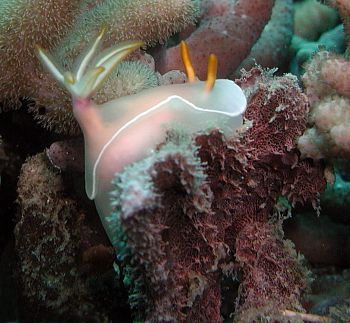
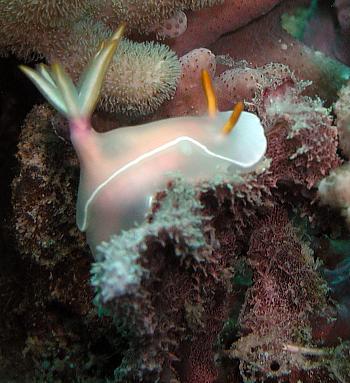
Dear Bill,
Here are some more photos of H. bullocki that were also in the immediate vicinity. There were 4 or 5 nudis on the same rock or nearby.
These were shot at Tenggol Island off the coast of east Malaysia on 24 May, 2002. Depth was 13m.
Kheong.
kschan@mail.dsi.nus.edu.sg
Chan, K.S., 2002 (Jun 5) Hypselodoris bullocki feeding. [Message in] Sea Slug Forum. Australian Museum, Sydney. Available from http://www.seaslugforum.net/find/7111Dear Kheong,
Thanks again. These photos show 'typical'
Best wishes,
Bill Rudman
Hypselodoris bullocki - different colours mating
June 5, 2002
From: Kheong Sann Chan
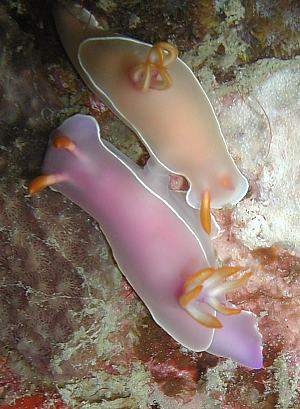
Dear Bill,
Here are the pics of H. bullocki mating, one white one and one purple one. There is also a ribbon of nudi eggs not too far from this couple, that seems to be rather old and broken. The white nudi seems to have lost its left antennae, maybe bitten off by a fish.
Location was Redang Island, Malaysia
Date : 26 May 2002, 5:30pm.
Depth : 17m
Kheong.
kschan@mail.dsi.nus.edu.sg

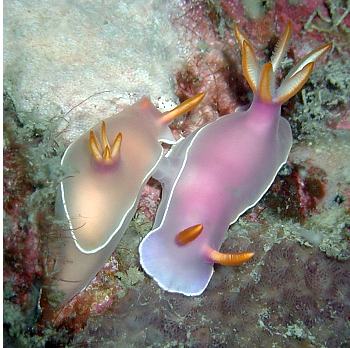
Thanks Kheong,
When I saw your message title I thought this was going to be a photo like Phil Slosberg's showing typical H. bullocki and 'Risbecia apolegma' mating. However your photo shows two 'shades' of 'typical' H. bullocki mating. Not quite as exciting but a nice piece of comfirmation.
Best wishes,
Bill Rudman
Thank you Bill - Hypselodoris bullocki
May 14, 2002
From: Ike
Dear Bill,
I must say that your site is the most informative that I've found. I am old to fresh water, but new to salt. I decided to convert my 40 gal. to salt, conditioned the tank, and got sucked into the nudibranch gig. A local pet store is selling them and as you've heard so many times has no idea what they eat. I am so desperate to save him [Hypselodoris bullocki] that I even tried the "angel formula" by ocean nutrition. It is a frozen sponge formula consisting of mainly krill and a mixture of sponge. I even tried wrapping a thin plastic net around a dried sponge with the angel formula underneath in desperate hopes, but it seems like it just got him excited for nothing. I have printed off a few of you tasty messages "like feeding puppies or kittens bird seed" in hopes that she might reconcider selling these starving beutiful creatures. I am taking him back tomorrow to see if I can get a refund. I'm very disapointed in myself for not researching nudibranches in the first place. Thank you for opening my mind, such a small hope, such a stunning species!
Thank you again,
Ike
kkollath@new.rr.com
Ike, 2002 (May 14) Thank you Bill - Hypselodoris bullocki. [Message in] Sea Slug Forum. Australian Museum, Sydney. Available from http://www.seaslugforum.net/find/6939Dear Ike,
I had forgotten about my bird seed comments. Sorry you have had to find out the hard way. I am sure most aquarium shop owners like animals so the only way to stop this trade is to do what your are doing - let them know that what they are doing and saying is wrong.
Good luck,
Bill Rudman
H. bullocki 'colour forms' mating
May 1, 2002
From: Erwin Köhler
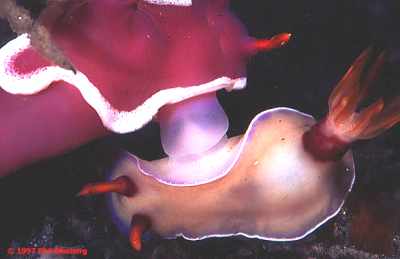
Hi Bill,
I think I found on the web what you are looking for: 2 different colour forms of Hypselodoris bullocki mating. Phil Slosberg shows it at
http://www.cybereef.com/opisthobranch_site/refpages/3002-06-10LG.htm.
It has the caption: Hypselodoris bullockii, enlarged view mating pair of two color variations. Lembeh Straits, Sulawesi, Indonesia. PHOTO: Phil Slosberg.
Cheers,
Erwin
Erwin@medslugs.de
Köhler, E., 2002 (May 1) H. bullocki 'colour forms' mating. [Message in] Sea Slug Forum. Australian Museum, Sydney. Available from http://www.seaslugforum.net/find/6816Dear Erwin,
Thanks for drawing my attention to this photo. I have contacted Phil Slosberg who has given me permission to post a copy on the Forum. I asked him if the photo was 'posed' or 'natural' and he replied:
"As to background, this was a pair that I just happened to come upon in flagrante delicto nudibranchio. It is the first and only pair of such divergent color variation and size that I have ever encountered. I would assume it to mean that since they mate, they are color variations of the same species rather than different species, but I would be very interested to hear your more learned views on the matter". .. Phil Slosberg
This is a rather interesting photo as it certainly raises the question of how we define a 'species'. This is not a close 'look' at each other, or even an exploratory 'jab' with the penis. This appears to be two animals mating. As Clay Carlson notes in a separate message, this white bordered colour form has recently been named as a new species. This photo certainly gives us something to think about.
Best wishes,
Bill Rudman
Hypselodoris bullocki from Malaysia
April 26, 2002
From: Kheong Sann Chan
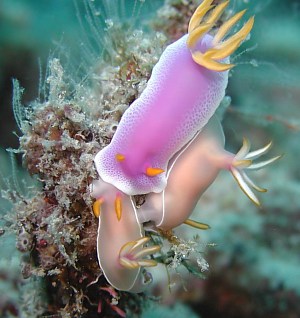
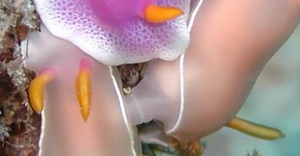
Hi Dr. Rudman,
Here is another photo I recently snapped at Pulau Dayang off the East Coast of Malaysia. Depth varied approximately 15-23m deep. [14 April 2002]
Kheong.
kschan@mail.dsi.nus.edu.sg
Sann Chan, K., 2002 (Apr 26) Hypselodoris bullocki from Malaysia. [Message in] Sea Slug Forum. Australian Museum, Sydney. Available from http://www.seaslugforum.net/find/6757Dear Kheong,
In this photo you have 2 animals mating and a third one at the top which is probably a different species. The mating pair are definitely Hypselodoris bullocki. At the moment I have included the third animal on the H. bullocki page until we sort out just how mnay species there are in this complex of similarly shaped and coloured species. See Bernard Picton's message for further pictures of this animal.
Best wishes,
Bill Rudman
Hypselodoris bullocki colour group (2)
April 9, 2002
From: Bernard Picton
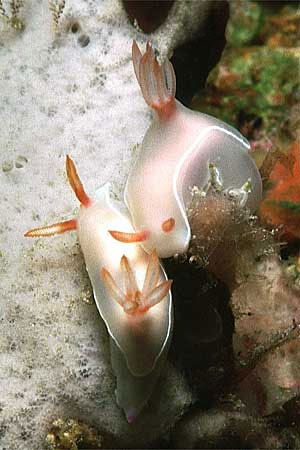
Hi Bill,
Here is a scan of a small form of Hypselodoris bullocki mating. This has a more transparent mantle, pink rather than purple, and a very fine white line at the edge of the mantle. The rhinophores are red and the gills are red at the tips and base, paler between. It is typically about 2cm in length. Compare this animal with the one in my separate message.
Bernard
bernard.picton.um@nics.gov.uk
Picton, B., 2002 (Apr 9) Hypselodoris bullocki colour group (2). [Message in] Sea Slug Forum. Australian Museum, Sydney. Available from http://www.seaslugforum.net/find/6428Thanks Bernard,
Bill Rudman
Hypselodoris bullocki from Bali
March 22, 2002
From: Stuart Hutchison


Hi Bill,
Here's photos of Hypselodoris bullocki from Bali, Indonesia on 24 Oct 2001. Lengths were 50mm for the adult and 30mm for the more juvenile. Depths were 30m and 15m respectively.
Regards,
Stuart
stuart@stuarthutchison.com.au
Hutchison, S., 2002 (Mar 22) Hypselodoris bullocki from Bali. [Message in] Sea Slug Forum. Australian Museum, Sydney. Available from http://www.seaslugforum.net/find/6295Thanks Stuart,
Bill Rudman
Hypselodoris 'bullocki' again
January 5, 2002
From: Mary Lefebvre


I was told from the people we got this from that this particular nudibranch is an algae eater, like a "lettuce" nudibranch. However, he is not eating (surprise, surprise...).
The central area is solid purple. The behavior, in case it helps: He wanders up as high as he can go, then "surfs" like in the second picture for about 5 or 10 minutes, then finally lets go, drifts in the current, and starts over again.
By the way, there will be more pictures posted soon with our other tank pictures at http://www.arches.uga.edu/~mlefebvr, including the baby cardinalfish and other things.
Thanks for any help.
Mary Lefebvre
mlefebvr@arches.uga.edu
Lefebvre, M., 2002 (Jan 5) Hypselodoris 'bullocki' again. [Message in] Sea Slug Forum. Australian Museum, Sydney. Available from http://www.seaslugforum.net/find/5875Dear Mary,
Have a look at my reply to Alexandra's message. This is a 'form' of Hypselodoris bullocki which is a specialist sponge feeder. All nudibranchs are carnivorous. The "lettuce" nudibranch your supplier mentioned is Elysia crispata and is a herbivore. However it is not a nudibranch, but a related group of opisthobranchs or sea slugs, which are known as sacoglossans.
As you will see from previous messages, aquarium suppliers are not a good source of accurate information on sea slugs.
Best wishes,
Bill Rudman
Hypselodoris bullocki mating in aquarium
November 27, 2001
From: Nick Gill
Dr. Rudman,
I have recently purchased a pair of Hypselodoris c.f. bullocki for my aquarium. They are the blue colour form with a thick white border and bluish magenta colored cerata. After I introduced them into the aquarium, they started crawling around. After ten minutes, I saw they were sitting side to side. Each nudibranch's head was beside the other's rear. One of them had extended its reproductive appendage. After a while, they crawled away. I am hoping that they will produce eggs. I know that there is a possibility that this was induced by stress, but is it possible for them to produce fertile eggs from this mating?
Thanks for replying,
Nick Gill
hongqixian@hotmail.com
Gill, N., 2001 (Nov 27) Hypselodoris bullocki mating in aquarium. [Message in] Sea Slug Forum. Australian Museum, Sydney. Available from http://www.seaslugforum.net/find/5721Dear Nick,
While egg-laying can be a result of stress, mating is just something they do when they come into contact with each other. It is possible they, or one of them, will lay fertile eggs, but without food they may not be able to produce sufficent yolk or the protein needed for the egg capsules. Even if viable eggs are produced it is unlikely that the planktonic veliger larvae will survive as they will need particular planktonic unicellular algae (phytoplankton) to feed on until they are ready to metamorphose into a bottom dwelling slug. The larvae also need some chemical trigger, usually provided by their adult food sponge, to cause them to settle out of the plankton and change into a crawling slug. Basically I can't offer any words of hope - either for the adults, or for any potential second generation.
Best wishes,
Bill Rudman
Hypselodoris bullocki laying eggs?
September 8, 2001
From: Matt Stryker
Hello.
I just bought a Hypselodoris bullocki (i'm sure that's what it is) about a week ago, and like after half a week, it layed eggs! It was sitting on a PVC pipe in front of my overflow, so i decided to move it in case it got stuck. when i lifted it up, i found sort of an egg mass under it. it was some transparent jelly like thin with a yellow cloud inside. can nudibranchs reproduce without mating or is it possible that it can lay eggs without mating? could u please tell me more?
Matt Stryker
chongren_88@hotmail.com
Stryker, M., 2001 (Sep 8) Hypselodoris bullocki laying eggs?. [Message in] Sea Slug Forum. Australian Museum, Sydney. Available from http://www.seaslugforum.net/find/5161Dear Matt,
Have a look at Mike Miller's message for a good photo of its egg mass. You'll see the eggs appear as tiny yellow spots to the naked eye. Your description of a 'yellow cloud' does suggest your animal is in trouble. Often when nudibranchs are stressed they lay, or attempt to lay eggs. If they have mated and have fertile eggs they can quite often lay a normal egg ribbon in which the larvae develop quite healthily. However if they are very stressed, or have never mated, then they can go through 'the motions' of laying an egg, but instead of laying eggs in individual capsules, each with a portion of yolk, they just extrude quantities of yellow yolk into a mucous ribbon. It looks like that is what your animal has done.
All the 'egg ribbon' will be good for is fish food. Nudibranchs are all hermaphrodites, each with a full functioning male and female reproductive system. In Mary Jane Adams's photo you can see a pair of H. bullocki mating. In most nudibranchs, mating consists of an exchange of sperm between the partners.
Best wishes,
Bill Rudman
Colour forms of Hypselodoris bullocki mating
August 29, 2001
From: Mary Jane Adams

Hi Bill,
Here is another image from Lembeh Straits, Sulawesi, Indonesia. I would love to know what the offspring of such diversely colored parents look like.
Divesite: Nudi Falls, Depth: 7 meters.
Best regards,
Mary Jane
divepng@yahoo.com
Adams, M.J., 2001 (Aug 29) Colour forms of Hypselodoris bullocki mating. [Message in] Sea Slug Forum. Australian Museum, Sydney. Available from http://www.seaslugforum.net/find/5167Dear Mary Jane,
What a wonderful find! I am not sure that all the colour 'forms' I have accumulated on the Hypselodoris bullocki pages are in fact one species, but I have been pretty sure that some of them are. Your photo of these two colour forms mating is pretty convincing evidence that these two are the same species.
I don't know how else to say that this is an important discovery - just as important as finding a new anatomical character. So please, anyone out there with interesting photos of animals eating, laying eggs, or mating - especially if the pair are badly matched in colour, please send them in.
Best wishes,
Bill Rudman
Hypselodoris bullocki questions
July 2, 2001
From: Drew
Hi, I have a little question, and I wonder if someone could help me. I've got a 4 inch pink Hypselodoris bullocki in my aquarium. Recently, it laid what I think is an yellow/beige egg ribbon on one of the walls, however, it is in a straight line, not in the rosettes I've seen picture of. Is this indeed an egg ribbon?
Also, I've got some run-of-the-mill mushroom coral in my tank, and the nudibranch motored over them once but didn't seem to take notice. Should I be worried? Will this animal consume my mushrooms?
Finally, it always positions itself underneath the water return, and its... gills? or whatever the thing that look like an umbrella growing out of it's back is, gets quite blown around. Is this normal? Does it mean I need more oxygen in my tank? The fish are fine, do nudibranchs have high oxygen requirements?
Drew.
ralphoo@onebox.com
Drew, 2001 (Jul 2) Hypselodoris bullocki questions. [Message in] Sea Slug Forum. Australian Museum, Sydney. Available from http://www.seaslugforum.net/find/4581Dear Drew,
If you read some of the other messages about H. bullocki in aquaria you will see that your animal is probably not very healthy. Certainly it normally lays a spiral egg ribbon - and there are a number of photos in previous messages. Often nudibranchs lay their egg ribbons in a straight or irregular way when they are stressed. Its biggest problem is the lack of food. Your coral is quite safe as H. bullocki is a sponge feeder, but unfortunately not any sponge will do. It will only eat one or a few related sponges from its native habitat - and unfortunately we don't know which species of sponge they are. And although your live fish dealer will say they are plant eaters, he is wrong, and sadly he won't have the sponge your animals needs either.
The umbrella shaped things on its back are its gills. I am sure if your fish are happy then there is enough oxygen in the tank for the nudibranch. Some nudibranchs seem to prefer moving water, perhaps its because the sponges they eat need currents to live healthily.
Best wishes,
Bill Rudman
Re: Purple sea slug in aquaria
May 24, 2001
From: Alexandra Ellwood
Thanks for your advice! I sent a message to Aquacon asking them to reconsider selling these animals as algae eaters. Unfortunately the myth that they eat algae seems so widespread in the aquarium trade that I doubt they will listen. My local fish store said their own distributor offers these very same nudibranchs as algae eaters.
Sadly, my nudibranch problem was solved last night. I walked in on a very excited feeding frenzy of Lysmata shrimp (three skunk and one fire shrimp) holding pieces of nudibranch. Even my Fungia sp. coral had managed to steal a piece. The fish and peppermint shrimp seemed uninterested.
Since I had seen the nudibranchs crawling safely on the cages around my pump intakes, I really doubt they died in the pumps. I think either the shrimp or fish initiated the attack once the slugs were sufficiently weakened by hunger.
Anyway, I guess they're not poisonous. Other than a rather full skimmer cup, the tank and remaining inhabitants were fine this morning. :-)
Thanks again,
lxs
lxs@mit.edu
Ellwood, A., 2001 (May 24) Re: Purple sea slug in aquaria. [Message in] Sea Slug Forum. Australian Museum, Sydney. Available from http://www.seaslugforum.net/find/4394Purple sea slug
May 13, 2001
From: Alexandra Ellwood
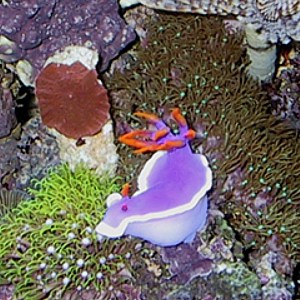
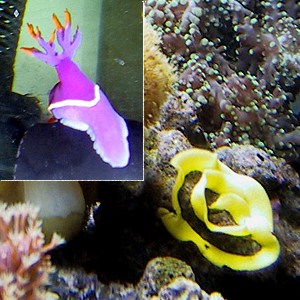
Hi,
I'm actually a reef tank owner, not a diver. A week ago, I bought two "purple nudibranchs with orange antennas" from Aquacon
Aquacon claims that these nudibranchs eat green algae. Since I haven't seen them eating any of my corals, they either eat algae or something I don't have. Both slugs are 2-3" long depending on how stretched out they are. What type of sea slugs are they, and what do they really eat?
Today, I looked into my reef tank and saw a spiral of bright yellow ribbon in the tank where one of the nudibranchs had been hanging out yesterday. Is this an egg ribbon? I can try to get better pictures of the yellow ribbon tonight if it hasn't been eaten by my hermit crabs (they were checking it out when I left). The above pictures are just my 10 second attempt with the digital camera this morning in case it disappeared.
You can check out my coral reef tank here:
http://web.mit.edu/lxs/www/corals.htm.
Alexandra
lxs@mit.edu
Ellwood, A., 2001 (May 13) Purple sea slug . [Message in] Sea Slug Forum. Australian Museum, Sydney. Available from http://www.seaslugforum.net/find/4316Dear Alexandra,
I checked out Aquacon's website and as you say they have an illustrated advertisement for:
REEF SAFE PURPLE NUDIBRANCHS W/ YELLOW ANTENNA'S !
Add bright color to your tank and take care of algae at the same time! If you have nasty green algae on your rocks and/or glass these clean up guys will move along and help you with your tank in a hurry. (2 - 3") $15.00 ea. / 3 for $40.00 GREAT FOR BEGINNER'S
This is of course quite incorrect. Your purple slug is what I am calling Hypselodoris bullocki. There are now three pages of messages concerning this species on the Forum, many of them from aquarium keepers wanting to know how to feed them. The short answer is that anyone who tells you they eat green algae either doesn't know what they are talking about or is trying to trick you. In either case I think you should complain. As you will see in earlier messages Hypselodoris bullocki is a carnivore, feeding on sponges. Unfortunately we do not know which species of sponge it eats, but I would suspect that like related species it will only feed on one or two partcular species. Your supplier obviously dowsn't know what species they feed on so he won't be able to supply it for you. The other major problem is that even if you knew which sponge to feed it, keeping sponges alive in aquaria is difficult. And keeping sponges alive, while they are being eaten is even more difficult.
Concerning the egg ribbon. Yes it will be your slugs. I'm afraid egg-laying is not a sign of well-being, in fact it is often a sign of stress.
Sorry I can't give you better news,
Bill Rudman
Feeding a Hypselodoris bullocki
April 10, 2001
From: Sammy Anderson
I have a Hypselodoris bullocki and he's not very happy now, since he's not been eating for a few days. The LFS said he would eat a special type of frozen food, but he doesn't. After reading through the Forum, I've found out that he will only eat a special type of sponge. He is bright purple with white trim and orange tips (photo E). Has anyone pinned down exactly what type of sponge he will eat? Please help, i don't want him to die. Thanks in advance...
Sammy Anderson
existenz@charter.net
Anderson, S., 2001 (Apr 10) Feeding a Hypselodoris bullocki. [Message in] Sea Slug Forum. Australian Museum, Sydney. Available from http://www.seaslugforum.net/find/4118Dear Sammy,
As you will see from other messages on the Forum, these fish shops have no right to say they know how to feed nudibranchs when clearly they don't. I'm afraid that even if we knew which species of sponge your animal ate, there is little chance of getting it for your aquarium.. Even if by some miracle you got the sponge, keeping it alive while it was being slowly eaten by your nudibranch, would be almost impossible.
I'm sorry I can't give you good news. The only thing I can advise you to do is go back to the LFS that sold you the Hypselodoris and tell them what you think of their spurious advice.
Best wishes,
Bill Rudman
Colour variation of Hypselodoris bullocki
April 6, 2001
From: Drew Taylor

Dear Bill,
Here is another colour variation of Hypselodoris bullocki from Exmouth ( North West Cape, Western Australia) to cmpare with my earlier photos.
This photo was taken in August 2000 at a depth of 14m in Lighthouse Bay.
Regards
Drew Taylor
orcaunderwater@nwc.net.au
Taylor, D., 2001 (Apr 6) Colour variation of Hypselodoris bullocki. [Message in] Sea Slug Forum. Australian Museum, Sydney. Available from http://www.seaslugforum.net/find/4071Dear Drew,
These are definitely an interesting group of animals. I find it interesting that most amateurs with more than a passing interest in nudibranchs, feel as I do, that all these 'colour forms' are somehow related, despite the fairly distinct differences in colour pattern.
Any further help with 'biological clues' such as egg masses, sponge feeding etc, is always welcome.
Best wishes,
Bill Rudman
